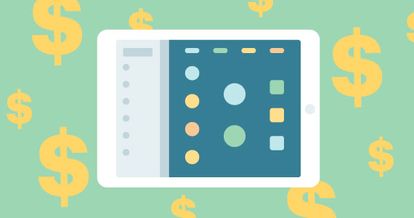Restaurant marketing is largely about rewarding your customers.
You run promos to entice customers to buy more. You engage with customers on social media to make them feel special.
And you like to make customers feel welcome as soon as they walk through your door.
Everyone wants to be rewarded for going to their favorite restaurant. So here we’re going to tell you everything you need to know about mobile marketing for restaurants: a new channel for restaurants to generate more regular customers.
For example: The Starbucks customer loyalty app uses mobile marketing and gamification techniques to send their customers notifications on opportunities to score double the “stars” on their purchase. And when Starbucks experiences slower traffic from 2:00–4:00 pm, they create a 2 for 1 drinks promotion and send app users a notification, encouraging them to visit a Starbucks and bring a friend.
But we know that a lot of restaurants can’t afford to pay for expensive app development. Thankfully this isn’t your only answer – many companies offer an affordable option, which involves “white labeling” – a templated restaurant app solution that allows you to re-skin a ready-made app with your restaurant’s brand, rewards, and messaging.
Here’s what a standard customer loyalty app looks like:
- Restaurant logo and brand
- Personalized restaurant rewards
- Order ahead functionality
- Mobile notifications
- Back-end customer analytics
Customer loyalty apps essentially power your mobile marketing strategy. Here’s how to use mobile restaurant marketing to build customer loyalty for your business.
How to Use Mobile Marketing for Restaurants to Build a Customer Connection
Research shows that our brains react favorably to the sound of our own name. Mobile loyalty apps allow you to collect your customers’ names when they sign up.
A study in the Journal of Applied Social Psychology showed that customers tip 23% more when they are given a mint at a restaurant when they receive their bill.
But the mint alone wasn’t what prompted the increase in tip. The study concluded that the feeling of personalization is actually what prompted customers to tip more.
So use your loyalty program to create that same feeling, by collecting your customers’ names and including them in mobile notifications.
One-Time Rewards to Create a Sense of Urgency
Mobile loyalty apps track how long your customer has been away from your restaurant and the app – and give you a way to reel them back into your location.
For example, if a customer has been away for 30 days, you can use mobile marketing to send a personalized notification through your loyalty app, prompting that customer to come back for a one-time discount or reward.
The first key is to create a sense of urgency: let them know they have to visit your restaurant within a certain timeframe to collect the reward. For instance, if one of your leap year marketing ideas is to give your loyal customers an extra 29 points for one day only, it’ll create urgency due to the deal only being available for a limited time.
The second key is personalized messaging: send them a reminder that you miss them and want them to come back to your restaurant. Use their first name. Customers will feel valued and be more likely to return.
Push Notifications to Encourage Return Behavior
Mobile marketing for restaurants provides you with direct access to users who have demonstrated an interest in interacting with your business. So you definitely want to make sure you’re taking advantage of your privileged access to this pool of customers.
The “Marketing Rule of 7” states that potential customers needs to “hear” the advertiser’s message at least seven times before they’ll take action to buy that product or service – and a survey conducted by SHIFT found that 82% of survey respondents open every text message and notification.
Use mobile marketing for restaurants to create the seven interactions you need to encourage return behavior. When a customer first signs up to a loyalty program, they’ll receive a push notification when they receive enough points for rewards. When you send push notifications with special messages or one-time rewards, you’ll be helping your business reach that “Rule of 7” goal.

Using Mobile Marketing for Restaurants to Create Customer Referrals
We have two words for you: referral code.
Some loyalty apps reward customers for giving their friends a referral code to download your restaurant’s loyalty app. When you take advantage of this feature, you’re outsourcing your own mobile marketing efforts to your customers – which is pretty genius.
Customer referrals are important because the customer receiving the referral text is getting it from a personal source. According to a Nielsen study, 92% of consumers believe suggestions from friends and family more than they do advertising. Referral codes are a quick and easy way for your customers to spread the word about your business.
Use Order Ahead to Add the Value of Convenience
The number of orders placed via mobile apps grew by 50% in U.S. restaurants in 2017.
Order ahead functionality through your mobile loyalty app opens up accessibility and convenience. Think of the busy parent who’s on their way to their kid’s basketball game or the professional urban Millennial who doesn’t want to cook. People are gravitating toward ordering ahead, and so should your restaurant. (Just make sure your back-of-house can handle the extra influx of orders – not a bad problem to have!)
A Customer Loyalty App Provider You’ll Love
To take advantage of mobile marketing, you’ll need to first find a loyalty program that fits your business and customer base. A few questions to ask yourself and your potential loyalty app provider are:
- What are the goals I want to meet with my restaurant reward program?
- What type rewards are most important to my customers?
- Are there any loyalty programs I want to emulate?
There are two options for loyalty programs:
1. Marketplace loyalty programs
Marketplace loyalty is a shared platform. Customers will sign up for your loyalty program under the loyalty supplier’s name rather than your personal business. Your data and information is shared with other businesses, and cross-marketing occurs between businesses that also use the same loyalty platform as you.
Some of the more popular marketplace loyalty programs are those offered through third-party delivery apps. For instance, Uber Eats allows you to create a loyalty program for your restaurant through its app.
The benefit of this type of loyalty program is that you can quickly and easily provide incentives to customers for spending a certain amount or ordering a certain amount of times. The downside is that you have to compete with all the other restaurants on that app, making it tough to stand out.
2. Personally Branded and Independent Loyalty Program
Personalized and branded loyalty programs allow your brand to be front and center. The loyalty provider just works behind the scenes doing all the work for you, but your customer isn’t aware of this. This platform also isn’t shared, so you’re not competing with other companies as you would be with the shared marketplace loyalty.
Creating a personalized reward app is often the more expensive and labor-intensive option. However, third-parties loyalty providers can often provide a cost-effective solution that’s quick and easy to set up.

Once you’ve chosen your loyalty and mobile marketing provider, the next step is to create an action plan. Devote some time each week to manage your mobile marketing campaigns. Keep in mind that businesses are using the mobile marketing channel at only 38% capacity. Take the time to plan and build your loyalty with mobile marketing, and watch your fan club grow.
The key to mobile marketing is connection. When you create a connection that customers want to engage with, you’ll find it easier to follow that up with messages that are urgent, compelling, timely, and enticing. Mobile marketing for restaurants has officially gone from a “nice-to-have” to a “must-have” for every modern venue to help with guest engagement. The good news is that you don’t have to break your bank to play the restaurant mobile marketing game.
Free social media templates for your restaurant
Sign up for our free weekly TouchBistro Newsletter







